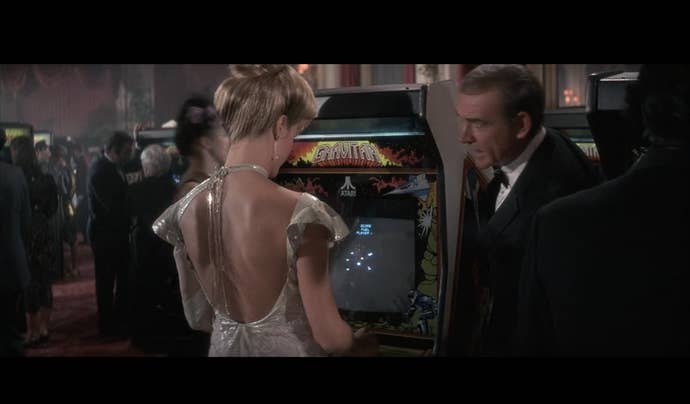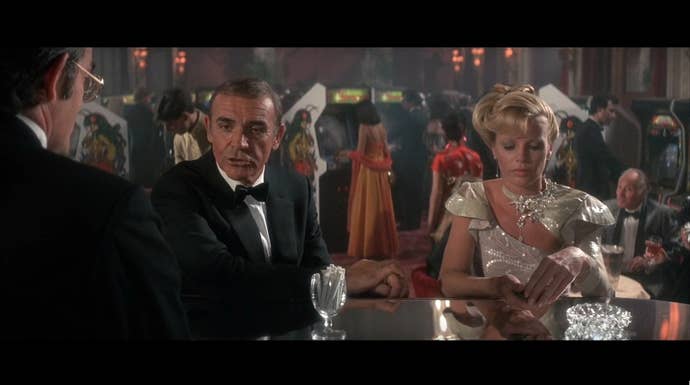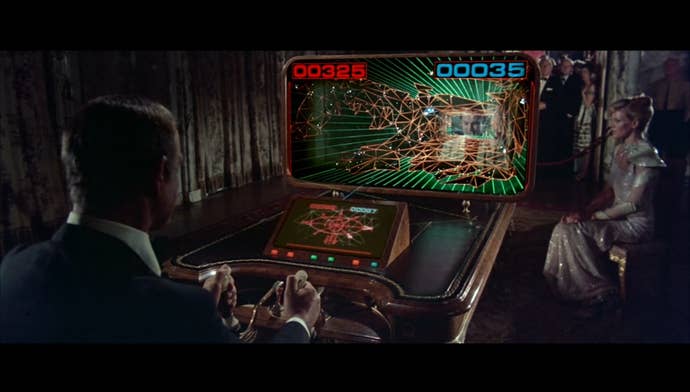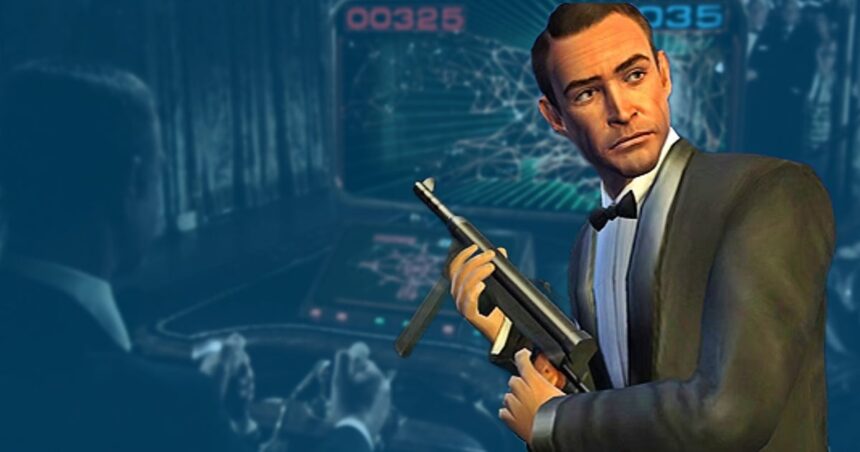Is there anything more British than turning on the telly at 11pm and finding an old Bond film on ITV? There’s an opening that I probably couldn’t get away with on any other major games site, hey. But, really: that moment of channel-hopping and catching the smirking visage of Sean Connery, Roger Moore, or Pierce Brosnan as a bit of late-night terrestrial TV filler is as British as fish and chips, potholes, and needing to do a blood sacrifice for his majesty’s government in order to send a DM on social media.
Anyway, the other night I had that classic experience. I was meant to be getting ready for bed but channel-hopped, as if that’s something anyone under fifty still does – and there he was. Sean Connery. Greying, undoubtedly phoning it in, but still brilliant. A mega ropey theme song played out over footage of his Bond on a training exercise without a psychedelic title sequence in sight. It’s Never Say Never Again, then – the redheaded stepchild of the Bond franchise.
Never Say Never Again is honestly rather rubbish, but it’s also fascinating. Even a crap Bond film has something about it – that Bondian stickiness – to draw you in. And with IO Interactive’s 007: First Light weighing heavily on my mind, I ended up rewatching the whole thing. Right through ‘til nearly 1am. Doh.
As noted, this film is bewitching in its mix of vague crapness and true directorial flair from Irvin Kershner (at this time fresh off directing a little independent film called The Empire Strikes Back). Also compelling is its status in legal purgatory, and how it thereby has to differentiate itself from the ‘main’ franchise. That last point is how this all tenuously connects to video games, which I’ll come to in a moment.
First, it’s important to understand why this film exists. If you’re not a Bond aficionado, an extremely truncated summary is this: there were several years where Bond’s literary adventures were a hot ticket. It wasn’t a question of if a movie would be made, but when. In the late fifties and early sixties but before Dr. No entered production, Bond creator Ian Fleming worked with a Hollywood writer and producer on a screenplay, and then later adapted that story into a novel, Thunderball. That screenplay struggled to gain traction, and in the end Fleming started making Bond movies with a different company. Cue legal limbo.
The co-writing producer in question, Kevin McClory, claimed partial rights to Thunderball. He was involved with the film of the same name, but then fell out with Bond’s producers. Lawsuits flew back and forth, and in the eighties McClory was able to mount an assault on the Bond franchise by making his own rival movie. Thus Never Say Never Again, the unlicensed Bond film that went head-to-head with Roger Moore’s Octopussy. In many ways it is Bond from Temu, except it stars the original Bond, with Connery returning to the role out of what appears to be an equally balanced thirst for a paycheck and revenge, as Connery too had fallen out with those behind the ‘official’ franchise.

Even if you’re not a Bond fan, it’s a truly gripping and amusing tale of Hollywood nonsense – there’ve been books written about these legal wranglings, and McClory’s exploits were directly responsible for many twists in the Bond film franchise. Why did the shadowy Spectre organization and Bond arch-enemy Ernst Stavro Blofeld disappear from the narrative? Being present in Thunderball, they were characters McClory could lay a legal claim to. Why did Timothy Dalton’s tenure as the agent sputter out after just two films? Legal battles with McClory forced the franchise to take a then-unprecedented six-year break. And why did Spectre and Blofeld return in 2015? Well, McClory died – and once he was no longer around, his family was quite happy to secure the bag to bury the fifty-year hatchet and hand over the rights.
All’s well that ends well, but back in 1983 it was still war. The unofficial Bond group had a problem, though: they had rights to one story, and they also couldn’t hem too close to what the other producers were doing, as any ‘innovations’ of the Bond franchise displayed in their films technically belonged to that group. That leads to a film that desperately wants to be part of the Bond franchise but can’t copy key elements. It’s also based on Thunderball but doesn’t want to be identical to Thunderball as everyone had already seen that movie almost twenty years prior.
There’s no Aston Martin – instead Bond is back in a Bentley, as that’s what he drives in the related book. There’s no fancy animated title sequence, as that was something the other guys did. The film goes to great lengths to differentiate itself; Q is a jokey type eager to hear about Bond’s violent exploits, and Felix Leiter is black, a bit of casting later mirrored in Daniel Craig’s films. Then there’s the casino sequence.

Anyone who has seen or read Bond media knows the casino scene. The hero and villain face off at the table over cards. They needle each other with bets and quips. Animosity is sewn that will be paid off in violence later. In Thunderball, this scene exists where Bond and villain Emilio Largo face off in baccarat chemin de fer. This scene is in Never Say Never Again also – except it’s differentiated in the most fabulously eighties way imaginable.
Largo is given a decade-appropriate makeover as an annoying nerd with a bad haircut. He’s eighties Elon. The eyepatch and menacing snarl is gone. And instead of hanging out in a high-stakes casino, he hosts guests in a casino side room, inviting folk clad in tailored tuxedos and elegant dresses to… an arcade. A suited and booted Sean Connery leans against a beautiful then-new arcade cabinet for Atari’s Gravitar that was almost certainly product-placed and flirts with the female lead as she plays the machine. Rather than the quiet ambience of cards against felt and roulette balls rattling on the frets, these classic Bond scenes are awash with the bleeps and bloops of an eighties arcade. It’s bizarre. I love it.
When it’s time for the showdown with the villain, Largo reveals he has programmed his own video game called ‘Domination’. It’s hard to understand how this game is supposed to work, but it involves simulating nuclear war between two great powers. The controls give each player electric shocks if they perform poorly. “Eternal battle for the domination of the world begins,” raps the robotic voice of the wood-panelled arcade machine. The whole thing is a clunky metaphor for the conflict at the centre of the film, obviously. It’s got all the classic scenery-chewing dialogue from this sort of scene, the villain snarling about the need to “share the pain of our soldiers” and all that. It’s a staple franchise scene… just over an arcade game.

It’s an incredible time capsule. I think it represents a few different moments in time. Never Say Never Again released in the wake of Star Wars and just a year after Tron. Gaming was enormous, even though the great industry crash was imminent. At the time this was made science fiction and video games were in vogue. It also obviously serves a purpose in transforming Thunderball too, as these scenes take on a completely different vibe despite serving an identical story purpose.
Nevertheless, this is a distinctly Bondian viewpoint of our fabulous hobby. It envisions a world in which arcade games are to become the sort of thing that the sophisticated upper echelon of society might gather and experience just as they might roulette.You can imagine how this conclusion genuinely didn’t seem so far fetched in 1982/3, before the great crash. Bond doesn’t belittle or raise an eyebrow at playing a video game – he sits down as eagerly to participate as he would for hold ‘em.
In the modern context, there’s something wonderfully mad about these people in diamonds and pearls huddled around Centipede and Dig Dug cabinets, and then gathering around to watch Bond and Largo play some digital nonsense for a quarter of a million dollars cash. This might make James Bond one of the first ever esports athletes, I suppose. Almost certainly the first on film? I can hear whoever is going to be editing this article groaning, so it’s time to stop. But, IO – I want to know. Is your new Gen-Z Bond a gamer? Could he beat Blofeld in Fortnite? I’m asking the important questions here.





